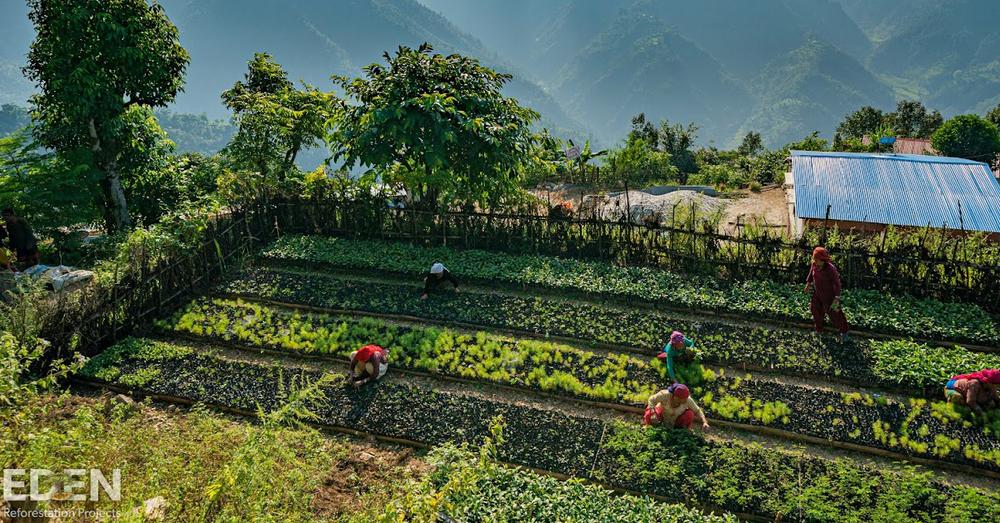IT TAKES A VILLAGE TO RAISE A FOREST
“60,000 new trees planted!”
We carry the nature in our hearts. Acting in a sustainable way is the main point in everything we do. As we use natural materials in our products, it is our responsibility to manufacture them with respect for nature. We also want to support projects that care about biodiversity and work in a way that supports local communities.
One of the foundations of our ecological activity is the planting of trees. We started planting trees in 2009, with the Finn Church Aid as our partner. In 2009-2019, we planted 55,000 tree seedlings together. In late 2020, we started a new partnership with the Eden Reforest Project. In the first year, we donated 60,000 tree seedlings, and in 2021, we managed to donate the same amount. At the beginning of 2022, we have donated total 175,000 trees and will continue to donate at least 50,000 seedlings annually.
WHY IS PLANTING TREES IMPORTANT?

Tree’s ability to absorb carbon dioxide is phenomenal. A growing tree absorbs carbon dioxide and old trees store it. It is also good to remember that a product made of wood stores carbon even after the wood has been felled.
Carbon absorbing is not the only wonderful function of trees. Photosynthesis is the process when trees produce oxygen and sugar from carbon dioxide and water through sunlight. The sugar produced, the glucose, is used for plants growth, but the oxygen is released into the atmosphere for us to use.
The roots of the trees keep the surface of the soil loose, allowing rainwater to soak into the ground instead of flooding on. The roots also bind the land in place on the coasts and in the mountainside and also prevent desertification.
Trees also provide shelter and nourishment for humans and countless species of animals and insects. Other vegetation also benefits from a prosperous forest.
EDEN REFORESTATION PROJECTS
“It takes a village to raise a forest.” Eden Reforestation Projects operates in eight countries, planting forests with the help of the local people. In addition to planting trees, the organization helps their workers to manage and offers the opportunity to take care of themselves and their families financially. The work can lift entire communities out of poverty and at the same time bring great results in the fight against climate change. Children can be provided with education. Better health care can be provided and safe housing can be built.

LOCAL SPECIES
Eden Reforestation Projects only plant local tree species in their reforestation areas. It is especially important to understand which tree species thrive in the area. Planting native species also supports the area’s natural biodiversity.
Areas are planted with tree species that are beneficial to communities and agriculture, so that trees planted as carbon sinks can grow in peace.
GROW, PLANT AND PROTECT
Eden Reforestation Projects uses different tree planting methods, depending on the planting area.
Some areas are regenerated by sowing seeds directly into the ground. Direct sowing is usually done during the rainy season, when the seeds get enough moisture to germinate. Seeds of fast-growing, local pioneer species can also be added in seed balls or seed bombs made from clay, compost, soil and seeds, which are dried and planted in small pits at the start of the rainy season. The seeds can also be sown in small bags, tubes and pots where they can germinate and grow into seedlings before planting.
Eden Reforestation Projects have nurseries where local workers plant and take care for tree seedlings before they are ready to be planted in the ground

These nurseries mainly grow slow-growing local tree species that are added to the fast-growing tree species to safeguard diversity. Nurseries also grow agroforestry species.

Trees drop seeds around them, from which new trees begin to grow. At the beginning of the rainy season, small tree seedlings can be collected from prosperous forests and transferred to other areas without causing any harm to the original forest. Only a small proportion of these seedlings would survive and be able to grow into an adult tree in their original habitat, so relocating them to a new habitat is warranted.
Some tree species are grown from the branches of the parent tree. The branch can be planted straight into the ground, or it can first be rooted in a nursery. The propagation of some mangrove species takes place by collecting seedlings growing from the branches of trees.
New forests are sown and planted in several ways, the most suitable of which are selected according to the specific features of the area. Employees at Eden Reforestation Projects also take care for the growth of planted seedlings and protect growing forests.
Planting trees is just one of our ways to protect nature. Read more here.


